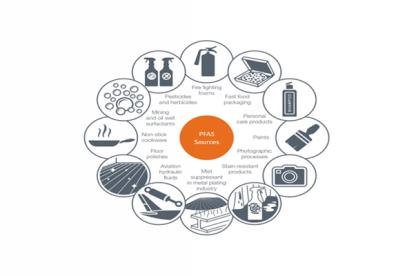
Cultural heritage: Indigenous and cultural heritage values driving sustainable development
by Flavia Kiperman
View post

This article explores how PFAS are gaining prominence in the UK, what impact this is having on different industries and how we can respond to the increasing awareness of environmental and regulatory risk.
PFAS (per- and polyfluoroalkyl substances), the so-called ‘forever chemical’ are a broad group of synthetic chemicals that have been widely used for industrial and consumer purposes since the 1940’s. They came to prominence due to their low thermal properties, ability to repel water, stability within the environment and ease of application. They were first mainly used for industrial purposes in firefighting foams (Aqueous Film Forming Foams, AFFFs) from the 1960’s but have since become commonly used in a host of other consumer applications and products, some of which include clothing (waterproof jackets), kitchenware (non-stick pans), food packaging (greaseproof paper), cosmetics (lipstick, shaving cream) and textiles (stain resistant coatings for upholstery and carpets).

Figure 1: Prevalence of PFAS in industrial and consumer applications (Australian Government, Department of Defence)
There are thousands of chemical compounds that are classed as PFAS, and it is these compounds which are the subject of accelerating environmental regulatory concern globally, because of their widespread detection in both groundwater and surface waters, often above acceptable levels. The prior regulatory focus has been on two individual compounds, perfluorooctane sulfonic acid (PFOS) and perfluorooctanoic acid (PFOA), due to a better understanding of their chemistry and toxicity, however an expanding range of PFAS are now regulated in many regions of the world, including the US, northern Europe and Australia.
Why is there a cause for concern?
The concerns with PFAS compounds are the very properties that make them so attractive for industrial and consumer applications, and which make them widely used, and in turn a significant health risk once released into the environment. They are usually highly mobile, but also persistent and hard to biodegrade, and therefore they remain in the water environment and can bioaccumulate in humans, aquatic life, plants and animals. In high doses they have various potential mutagenic and carcinogenic properties. These characteristics and the widespread distribution of PFAS are creating significant public health concerns. PFAS have been detected in penguin eggs in the Antarctica and polar bears in the Arctic, and more recently otters in the UK.
In 2016, PFAS were detected in drinking water in the USA which significantly impacted on potable groundwater supply availability. There have since been further cases worldwide. One of the challenges is that they are often present at very low concentrations and it’s very difficult to remove or breakdown PFAS using conventional water treatment technologies. As such they can recirculate within the water cycle.
In the UK, there has been no strong regulatory driver for the investigation and assessment of PFAS, despite having drinking water guidelines for PFAS since 2007, and whilst we have lagged behind other areas of the world this is slowly changing and gathering momentum. A recent step forward was the release of the revised Drinking Water Inspectorate (DWI) guidance on PFOS and PFOA concentrations in drinking water[1] in January 2021.
The Environment Agency has since announced expanded surveillance monitoring across a large-scale network of surface water within England[2] and projects such as the UKWIR Chemicals Investigation Programme (CIP2)[3] have launched. There has been a recent call for evidence, seeking ideas for controls under UK REACH[4]. Awareness in the mainstream media is growing, outside traditional environmental publications, which in turn applies pressure for action.
Why does all this matter?
Action is needed to prevent new PFAS being added to the environment and to manage and mitigate the PFAS already there. This may come in the form of planning or technical solutions that will need to be incorporated into assessments and designs. It is a continually evolving area and as more laboratory analysis, detection and remediation is carried out, the better understood they will become and the clearer the solutions to manage them.
Our clients are directly impacted by the need to assess and investigate the extent of PFAS that are present within their operations, across a number of areas, such as:
The range and risks associated with various PFAS sources are illustrated in Figure 2.

Figure 2: PFAS usage risk to the environment (after Weinberg & Leahy 2020)
Whilst PFAS has historically not been actively looked at within the UK environment sector, the direction of travel is for it to become a much more common contaminant of concern, with more informed regulatory guidance, toxicity modelling and risk assessment, allowing practitioners to better assess the significance of risk under a regulatory framework.
[1] https://defence.gov.au/Environment/PFAS/PFAS.asp
[2] Guidance on the Water Supply (Water Quality) Regulations 2016 specific to PFOS (perfluorooctane sulphonate) and PFOA (perfluorooctanoic acid) concentrations in drinking water
[3] Poly- and perfluoroalkyl substances (PFAS): sources, pathways and environmental data. Chief Scientist’s Group report. Environment Agency, August 2021
[4] PFAS and wastewater – Prevalence, reduction, option and costs UKWIR Ref; 22/WW/14/2, February 2022
[5] UK REACH – PFAS RMOA - Call for evidence. https://consultations.hse.gov.uk/crd-reach/pfas-rmoa-001/
[6] Weinberg, N & Leahy 2020, M, Sources and Exposures to PFAS in the Environment, EM, The Magazine for Environmental Managers, A&WMA , May 2020)

by Flavia Kiperman

by Jasper Schrijvers , Matthew Hoare

by Clodagh Connolly, Nicola Inge, Andres Schottlaender